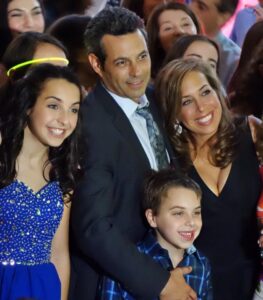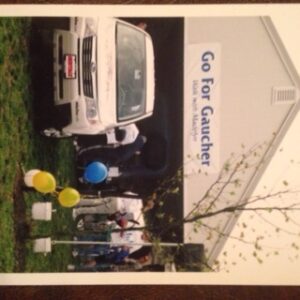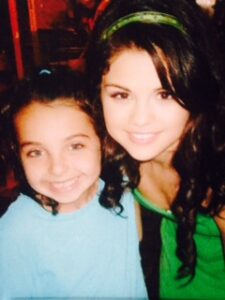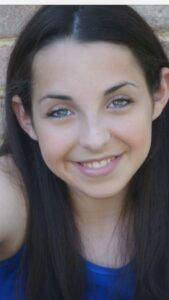What if I had your heart?
What if you wore my scars?
How would we break down ?
What if you were me, what if I were you?
– Lyrics from What If, by Five for Fighting
Everyone has a story. But sometimes the question is, when you meet someone do you stop to think about that? And if you do, and if you knew, would you want to trade places with anyone? Would you want to share your story? Do you have what it takes to show courage, offer hope, or be an inspiration to others?
The Sunday Series (44): Madelyn Backstage
She seemed almost too perfect: dark black hair, perfect skin, deep blue eyes. A beautiful baby girl – stunning. “Everyone said I should do something with her”, says her mom, Jenny Schloss. “My sister, a writer and producer in LA, guided me on how to get an agent. We got an agent in New York when Madelyn was only five-months-old. Her first audition was for the cover of American Baby magazine. Out of 100 babies, Madelyn was one of two to get the callback. I was in hook, line and sinker,” says Jenny. Less than half-a-year on this earth and Madelyn’s modeling/acting career was on its way… only challenge was the publishers of American Baby chose two babies in case one didn’t cooperate for the photo shoot, Madelyn was the one who didn’t cooperate. Gig over. But Madelyn still got booked and got paid. At five months of age a star was born.
A few years later that star began to flicker.
Jenny and her husband Adam had planned a weekend trip to Atlantic City, to stay at the new Borgata hotel and casino. Jenny was rushing around with last-minute plans, and so she barely had time to take Madelyn to the pediatrician to check out the cough she had been fighting for some time. Jenny says Dr. Rona Stein laid Madelyn down to feel her stomach. Feel her stomach? For a cough? Dr. Stein was just being thorough she said.
The extra touch proved to be a life-saver.
Dr. Stein said there was something about Madelyn’s spleen, it didn’t feel right and she told Jenny to take her daughter to get an ultrasound. Jenny admits it wasn’t her best day… she immediately thought the worst – “was it the C word?” There was no way to be sure until a test was done. They immediately headed for the ultrasound which showed Madelyn’s spleen and liver were enlarged, but, as Jenny puts it, “the good news was there were no tumors.” A fun weekend on the horizon in Atlantic City was now taking a backseat to a medical mystery consisting of tests and uncertainty surrounding her baby girl.
Now the attention turned to figuring out what Madelyn’s condition might be – enlarged spleen and liver, her blood platelets “off” – the family met with Dr. Joseph Wiley at Sinai Hospital in Baltimore who quickly gave them the diagnosis, Gaucher Disease. “It’s not possible”, said Jenny, “I’m not a carrier.” Gaucher Disease results from a specific enzyme deficiency in the body, caused by a genetic mutation received from both parents. It is also the most common genetic disease affecting Ashkenazi Jewish people with a carrier frequency of 1-in-10 affected. Jenny and Adam had both been tested before Madelyn was born and only Adam had been identified as a carrier, one parent, not both. Jenny says. “I told the doctor he was wrong.”
But Dr. Wiley had no doubt. When Jenny was tested pre-pregnancy it showed she could be a carrier of cystic fibrosis, but perhaps there had been a mistake. Whatever the genesis, the present results were clear, Madelyn had Gaucher Disease. At first the doctor said he didn’t believe the disease to have affected Madelyn’s bones, and because Madelyn was so young, they could wait about a year to begin infusions. But an MRI was scheduled and the results surprised even the doctor – the disease was in Madelyn’s bones, at least a little – and he recommended infusions begin immediately. Madelyn’s brother Jake, who was born before Madelyn was diagnosed was also tested and does not have the disease.)
Gaucher Disease can involve many organ systems, such as liver, spleen, lungs, brain, metabolism and bone marrow. It is also broken down into three subtypes according to the presence or absence of neurological involvement. Fortunately for Madelyn, the disease was Type 1 and there was no sign of neurological trauma, but others are not so lucky. Types 2 and 3 can cause severe trauma and even death. For 6-year-old Madelyn the treatment would be the infusion of Cerezyme, basically a drug to replace the enzyme she was lacking which kept her liver, spleen and platelets in order. (http://www.gaucherdisease.org/)
Jenny says she still recalls her fear and anxiety, calling friends and fearing the worst, her daughter had a disease for which she would need infusions for the rest of her life! Adam took the other road, for too many the one less traveled, but the one which brings calm and certainty to handling any disease – Adam did the research, learned about the treatments, knew it was caught early and was ready to accept that fact Madelyn had Gaucher, but would be OK.
That was of course until the first infusion. It was Adam who held his daughter in his arms for that first infusion at Sinai Hospital, held her tight as the needle went into her veins and the tears started to flow:
(The first infusion)
IMG_6639
After the first few infusions at the hospital, which needed to happen every two weeks, the treatments got a bit easier. The infusions, which have varied in frequency from two weeks apart to three to even four, are now back to a two week span, since Madelyn, at age 13 is now going through puberty and the doctor believes with all those changes, more frequent treatments are beneficial.
But the infusions have their own story. When any child is sick, it’s a sick feeling for those who love her or him the most, their family and friends. And it’s Jenny’s long-time friends who have been the beacon of light for Madelyn since the time the day the very first needle was injected. The friends, many of whom Jenny has known since she herself was a little girl, do a round-robin, bringing Madelyn a gift for EVERY infusion, never missing a beat. Early on Jenny says she would hold up the gift right at the moment the needle was going into Madelyn’s vein, just to serve as a distraction. Even now, as Madelyn begins her teenage years, the gifts keep on coming. And Jenny says it still makes a difference. There’s something about the knowledge others care, which never grows old, even as you do.
The support of an entire community has been on full display as well for Madelyn, and for all those children who have Gaucher. A few years ago the family held a Go for Gaucher event, a walk/run which raised $70,000 for the National Gaucher Foundation. And maybe just as important as the money raised, was the show of support – 450 people – many of them volunteers – participated in the event, proving once again it takes a village to help raise a child, especially when those children are in need.
And it’s Madelyn, who surrounded by those ready to help her at a moment’s notice, has learned the meaning of the word “give”. Madelyn has connected with other children also dealing with the disease through Skype chats, even talking to a 6-year-old girl while the young lady was getting her infusion – providing a show of support and a sense of calm and maybe most importantly hope, from a beautiful, vibrant 13-year-old who shares the same disease, but was telling her all would be OK.
For Madelyn, showing the world you can shine, despite any obstacle, or distraction, has become a daily part of her world. Since that first baby photo shoot went south 13 years ago, Madelyn has experienced plenty of success: modeling, acting, singing and showing the whole world how she can shine.
Yet despite all the success and the accolades which come with the bright lights of the stage, video and television, it might be the performance that only a few got to see last year, which is her shining moment so far. Jenny was kind enough to provide me with the speech Madelyn gave to her 7th grade class during something called Survival Week, (the speech is included below). Other people visited the class to talk about experiences they survived or endured, but Madelyn was the only classmate to get up and to share the experience she has lived since she was 6-years-of-age and will continue to live with for the rest of her life. It is permanent proof that Madelyn gets it. She knows that behind the curtain of all her success, the backstage of her life helps determine her front stage, and it has made her a stronger, more grounded individual, understanding what makes life important and gives it meaning is how you overcome, how you survive and live to shine.
Madelyn’s speech:
“The theme of this week is survival. The interesting thing about survival is that each and every one of us deals with survival in someway. Whether it’s how we survive a physical challenge, a dangerous situation or even how we deal with a simple every day sort of problem. The bottom line is that we are faced with some sort of obstacle and we have to choose how we are going to get through it.When I was six years old I was told I had Gaucher Disease. It’s a rare genetic disorder in which I am lacking a certain enzyme that I cannot even attempt to pronounce. My platelet count was low, my spleen and liver were enlarged and the Gaucher cells were starting to invade my bones. Dr. Wiley at Sinai Hospital said that I would have to get 2 hour infusions every two weeks to replace the enzyme that I am lacking. For the rest of my life.There were blood test, ultrasounds and MRIs. And soon after was my first infusion at Sinai Hospital. Eventually we arranged for a nurse to come to our home to do the infusions.It has been six years since my diagnosis. Now every two weeks my nurse, Karen comes to my house and every three months I go to Sinai for my infusion along with blood work and other tests. I guess the whole thing could be kind of annoying. I mean who wants to get a needle every two weeks for their entire life? And then have to sit hooked up to an IV pump for two hours. And who likes blood tests or loud MRIs that you have to lay still inside a tube for 45 minutes?One thing that I learned through this whole ordeal is that everything is relative. I get my infusions in the pediatric oncology department at Sinai. I see many children who lost all their hair getting chemo for their cancer. Most of them are actually upbeat, usually accompanied by their parents doing what they have to do to get better and survive.Some of my closest friends have food allergies. They struggle everyday always being cautious with every morsel of food that goes into their mouths. They read every ingredient on what they eat and ask waiters in restaurants all the right questions. They are always prepared with an EpiPen nearby just in case. They take precautions and educate themselves with the knowledge necessary to continue to lead a healthy life and survive.Most of my friends are lucky and do not have to deal with serious health issues. But I have friends who deal with other issues. Some struggle with family problems. Some have trouble focusing on their schoolwork and some have difficult situations with friends.The bottom line is that we all have struggles. The most important thing about that is how do we survive our struggles.When I get my infusions, I always have something in front of me to keep my mind occupied. Whether I’m studying for a Hebrew test or watching Pretty Little Liars.My mom has a group of friends who have been close since high school. All eight girls have a schedule where they alternate bringing me some sort of gift for every infusion for the past six years! As soon as Karen puts the needle in my arm, there’s a present sitting in front of me. These girls literally made me look forward to my infusions instead of dreading them.After I was diagnosed, my family, friends and I organized a “Go for Gaucher” walk to raise money and awareness for Gaucher disease. So many of you were there and helped us to raise $70,000 for the Gaucher Foundation. It felt so good to sort of get up and do something to fight this disease instead of letting it get me down.I also am in touch with other Gaucher patients through friends and social media. I speak to other children who have been recently diagnosed and give them advice on dealing with the disease.We will hear all different stories of survival this week. I am sure we will be inspired by each one. I know I am inspired by all the people around me who deal with their own issues. I hope I can help by sharing my story. I think the best way to get through something is to first accept it. Then figure out what you can do to not only get through it but do more than that. Figure out how you can turn a negative situation into a positive one. A way to maybe help yourself get through and even help others along the way. We all can do it. Survive any obstacle. But even better persevere!Until next time, thanks for taking the time.Mark BrodinskyMark Brodinsky, Author, Huffington Post Blogger, Financial ServicesThe #1 Amazon Best-Seller: It Takes 2. Surviving Breast Cancer: A Spouse’s StoryFor ideas and comments for The Sunday Series, e-mail markbrodinsky@gmail.com, or connect on Facebook, LinkedIn, or Twitter










Mark you should never ever ever stop writing… Ever!
Thanks Jenny 🙂
Quite an article today. Please let Madelyn know that her words about survival were truly
inspiring! Mom & Dad
Great story Mark. I remember every detail of day one when jenny first came in with Madelyn to the office for this. I also remember being part of the walk. It’s amazing how well she has done with and educated others around her.
Wow, beautifully written – both Mark and Maddie! Maddie is an inspiration to others and her family has taught her not just to survive it but to overcome it!